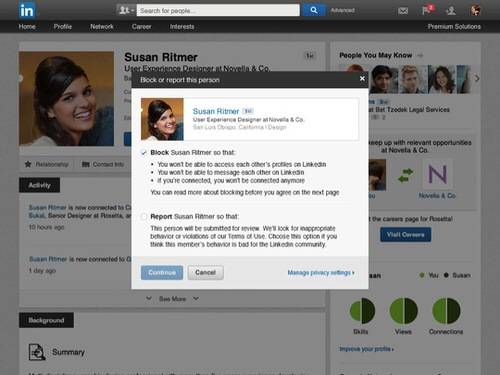When a San Francisco-based tech recruiter—we’ll call her “Sally,” a pseudonym—filed a restraining order against an ex-boyfriend, the court documents listed Facebook, Pinterest, and even Etsy as no-go zones for him. But it was LinkedIn that Sally was worried about.
“He started following what I was doing on LinkedIn,” Sally told me. “Who I was connecting with. He was trying to track what I was doing professionally. Every day I was seeing his face on my profile.”
LinkedIn’s basic features for connecting people became ways for Sally’s stalker to remind her of his presence.
“He started referring people to me, and connecting to people I was connecting with,” she said.
Sally had no way of stopping him, short of a court order. Neither did any of LinkedIn’s 300 million members, until LinkedIn finally rolled out a block feature in February of this year.
Why did it take so long?
Blocked On Blocking
The notion of blocking users is far from new. Instant-messaging systems like AIM and Yahoo Messenger have long had blocking systems to prevent users from contacting each other or even seeing whether another user was online.
Facebook had blocking since its earliest days; while the company’s press office couldn’t pin down an official date, Ezra Callahan, an early employee, believes it was present in 2004 or 2005, when the site was a simpler college-only network.
Twitter implemented blocking back in 2007 when the service was just a year old.
LinkedIn is actually older than Twitter and Facebook. When it was founded in 2003, it “started off with a big value of public profile information,” said Madhu Gupta, LinkedIn’s head of security, privacy and customer-service products. That was the big innovation of LinkedIn: It took something formerly viewed as private and personal, the professional resume, and turned it into something public.
It seems that LinkedIn’s founders, intending the service for professional networking, never anticipated that its members might use it for darker purposes. But as it added feature after feature, stalking became a reality.
In Sally’s case, her ex harassed her for two years on LinkedIn—sometimes in violation of the court order—before the new function allowed her to stop him for good.
Growing Pains
People had been asking LinkedIn to implement blocking for a long time. But LinkedIn had other problems to solve.
One was keeping up with the service’s explosive growth. In the last year alone, it’s added 100 million users.
Another was updating LinkedIn’s technical architecture, which was hobbling efforts to evolve the site.
After the company went public in 2011, the engineering team “struggled to hold the site together with the digital equivalent of chewing gum and duct tape,” Bloomberg wrote. To get back on track, LinkedIn’s engineering boss launched Project InVersion, an effort to rebuild the site from top to bottom. For months, the company froze development of new features. After InVersion was done, LinkedIn’s engineers could move much more quickly—but they had a massive backlog of projects to work on.
LinkedIn’s fast-growing member base meant more and more people on the site—and more problems, as the site became a must-visit for professionals who couldn’t avoid stalkers if they wanted to keep up with colleagues and stay relevant in their careers.
According to LinkedIn, the company was aware that users occasionally requested a block function. One of those users was Anna R., a LinkedIn member from Columbus, Ohio, who launched a Change.org petition in April 2013. That summer, LinkedIn executives learned about the petition, in which Anna R. related how a man who she said had sexually assaulted her in her workplace used LinkedIn to view her profile, an action which LinkedIn’s interface notified her of. The petition became a catalyst for change.
The frustration over this gaping hole in the company’s privacy settings was reasonable: Anna R. pointed out that every major social site allowed for blocking—even Pinterest.
But the expectations held by some users were not.
“To allow members to block stalkers would take ONE of your developers about ONE man-hour to implement. So why haven’t you done it?” one disgruntled member wrote.
In fact, it took six months, and hundreds of engineers across LinkedIn—a massive, companywide effort. Work began in earnest in August 2013.
Tackling Blocking
Blocking is far easier said than done. For one thing, what does it mean to “block” a user? Not everyone has the same answer.
Twitter faced its own blocking controversy last year when it announced it would change its blocking feature to “mute” a person. In the new version of blocking, the person could still follow the blocker. The idea was that it would reduce antagonism and the prospect of retaliation if people didn’t realize they’d been blocked.
It took outraged users less than a day to convince Twitter to reinstate the block function it just got rid of. (It has since introduced a mute function alongside the older block function.) Even so, Twitter’s blocking is imperfect: Because Twitter is a mostly public social network, anyone can see public tweets. The only way to prevent people from seeing your posts is to keep your account private.
One of the biggest challenges for LinkedIn was figuring out what, exactly, happens when someone is blocked.
“There are a lot of nuances as you start thinking about,” said Gupta, the LinkedIn security and privacy head who oversaw the project. “What happens when you block the member? What should that experience be when you come to my profile page?”
LinkedIn ultimately decided that when you block someone, they should be unable to see your profile or any content you publish. That includes any comments in groups you both might be a part of, or blog posts you publish to the site. It removes them entirely from your LinkedIn experience.
That product decision set the stage for the technical challenge.
“Every one of our applications like search, messaging, recommendations, all needed to implement their own version of how to filter out and how to filter out blocked members and not showing their content,” Gupta said.
Virtually every team at LinkedIn—26 product and service groups—had to be involved to make sure it worked correctly.

Putting LinkedIn To The Test
When one member blocks another, the two form a “blocking pair.” On nearly every page of the site, LinkedIn is looking at content from and relationships with dozens, maybe hundreds of other members. Looking through LinkedIn’s database of 300 million members for every interaction would bring the site crashing to a halt.
And to live up to Gupta’s vision of how blocking should work, every thing a member sees and does on LinkedIn has to respect any blocks other members had put in place.
“When we do a feature like member blocking, we have to touch more than 60 different front- and backend services—all the member-facing products you see,” Vicente Silveira, Director of Engineering Security Infrastructure at LinkedIn, said in an interview. “Profile, search, inbox—all those things are different features powered by a set of services that have to be changed to honor member blocking.”
The good news was that LinkedIn’s growing complexity of functions, like its new tools for publishing, also required quick ways to look up relationships and evaluate how closely two members are connected. The system for looking up “blocking pairs” could rely on some of that architectural work.
Rather than pinging a centralized database of blocked members every time, LinkedIn stored the information close to each service.
“We found a space-efficient manner to pretty much keep all the blocking info and all the services that needed it so they could do a local lookup,” Silveira said. “We provide the services these lists, so they can have a local copy they can check.” That approach provides “low latency,” Silveira said—meaning users don’t have to wait a long time for pages to load.
There was one more technical challenge: LinkedIn normally rolls out new features gradually to a small set of users to test response and catch bugs. With blocking, the team decided it couldn’t do that: Everyone should have blocking at the same time, and it needed to work across the service immediately.
The engineering team had to develop 50 new tests just to make sure member blocking worked across various versions of LinkedIn, including desktop and mobile websites and LinkedIn’s various apps. The engineering team also ran 18,000 existing tests to make sure the introduction of blocking didn’t break other functions.
The work LinkedIn did on blocking dovetailed into other development. One example is LinkedIn’s new publishing tools. The day before LinkedIn introduced blocking, the company opened up its publishing platform to a small set of LinkedIn users. (Previously, it had only be available to a few hundred famous business leaders like Richard Branson and Jack Welch.) These posts hit a customized audience, so LinkedIn needs to make sure it shows up for the right people in someone’s network—and doesn’t show up to someone who’s blocked.
LinkedIn may have been late to the game, but it arguably built a block feature that’s more sophisticated and sensitive than Twitter’s.
(For people still concerned about privacy even after they’ve blocked a user, it’s possible to tailor your public profile to prevent anyone outside of your network—including people who search for you online and don’t have a LinkedIn account—to see your name or profile.)
When Getting A Job Leaves You Exposed
When you sign up for a social network, you’re making yourself visible to the world in a way that was rarely possible before the rise of social media. And while there are many benefits—in LinkedIn’s case, it can help you get a job—the downside is that visibility can mean vulnerability.
Harassment and bullying are problems many social networks have, and ones that law enforcement is ill-equipped to deal with. It’s especially bad for women.
As feminist writer Amanda Hess writes:
“Ignore the barrage of violent threats and harassing messages that confront you online every day.” That’s what women are told. But these relentless messages are an assault on women’s careers, their psychological bandwidth, and their freedom to live online.
Our online lives have become just as important as our offline ones—and social media companies need to take steps to prevent online harassment that can affect us in the real world.
LinkedIn faced a lot of criticism, deservedly, for being late to introduce blocking. But from what ReadWrite has learned, after the company decided to make the feature a priority, it moved swiftly to solve a complex technical problem in a way that made blocking a meaningful safety measure—not just a quickly implemented, face-saving gesture to appease critics.
For Sally, the block function provides some sense of security, though she doesn’t think her ex-boyfriend has stopped stalking her online.
“I think [blocking] has anonymized it,” she said. “Do I think he’s still doing it? Absolutely. The good news is, I don’t have to see his face.”
Illustration by Bill Strain










